When the bowling ball rolls down the lane, it revolves around its axis. There are two points at the ends of the axis: the negative (NAP) and the positive axis point (PAP).
The NAP exists but is not important to bowlers because it cannot be seen while the bowling ball is in motion.
The PAP is important because it can be seen throughout a shot, and the bowling ball’s reaction is influenced by how far the pin and mass bias (core) are away from the PAP.
The pin is the circle marking on the surface of the ball and it indicates the location of the top of the core that is inside the ball.
For right-handed bowlers, the PAP will be on the right side of the bowling ball, and for left-handed bowlers, it will be on the left.
What the PAP identifies at release is your axis tilt and axis rotation.

While axis tilt is difficult to manipulate, axis rotation can be one of the better options to adjust when the lanes transition.
How to find your PAP
Finding your PAP is easier than you think. Start by throwing a ball down the lane. When it returns, it should have fresh oil rings on it. With an oil pencil, trace a line on the edge of the first oil ring nearest your finger and thumbhole.

Next, take your track line and place it so that it is parallel to the table or counter it is on. Mark the center on the top of the ball and put a piece of tape on it and you have your PAP.

Buying a bowling ball that hooks early or late is only part of the equation. Personalizing it to fit your needs is the other part. Knowing your PAP gives the pro shop operator a starting point to determine your layout.
You can lay out a bowling ball that hooks early or that hooks later by placing the pin in different locations when drilling a bowling ball.
Pin Closer to the PAP
The PAP is identified below with the white piece of tape. The pin is illustrated with the yellow circle drawn on the bowling ball. This pin placement creates an earlier hook with less back-end reaction. This layout is ideal for higher-volume oil patterns.
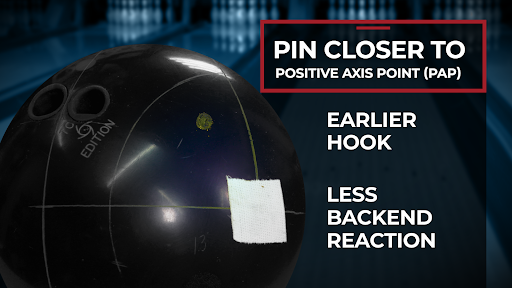
Pin Farther From PAP
This pin placement creates more skid and more backend reactions. This layout is ideal for lower-volume oil patterns. It’s also good when the lanes transition and become drier.
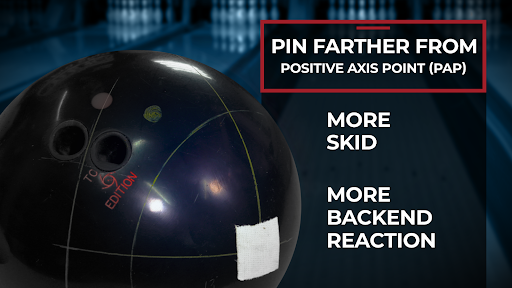
Pin in a Leverage Position
Both yellow circles below represent pin placement 3 ⅜ away from the PAP. The number on the X axis can range from 0 to 6 ¾ inches. At 3 ⅜ inches, the most flare and hook potential is created.
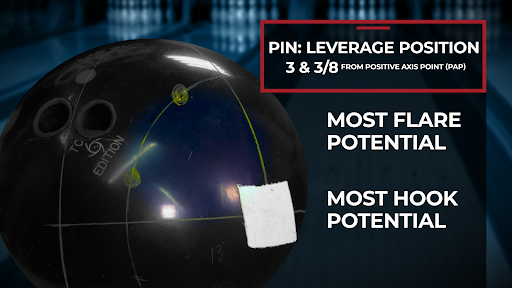
Pin Higher Than the Finger Holes
This pin placement delays the hook, providing a strong backend reaction. This is a good layout for lane transition and lower oil volume patterns.
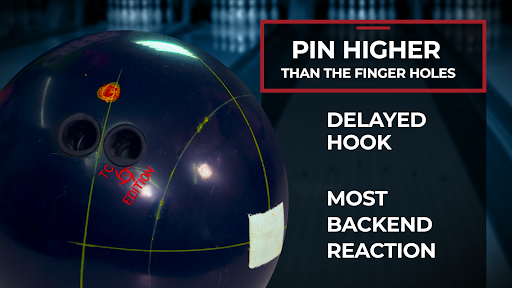
Pin Lower Than the Finger Holes
This layout is good for lower volume patterns and can be used as a ball to change out to when the lanes transition.
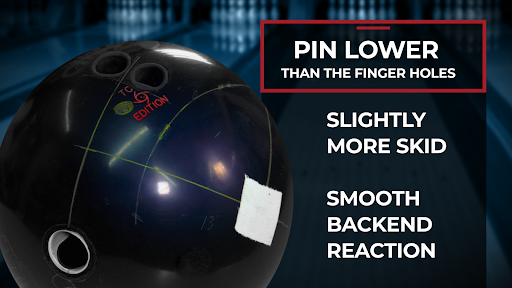
While pin placement makes a difference, remember that altering the bowling ball’s coverstock accounts for 75% of the bowling ball’s motion and that will be the largest contributing factor in determining when and where the bowling ball hooks.

Why do I keep getting this error message?? Oops. We're sorry, your choice of words didn't meet our submission standards.
test
Ball speed 10 mph PA P 4 over 1/2 up right Want the ball tho go long